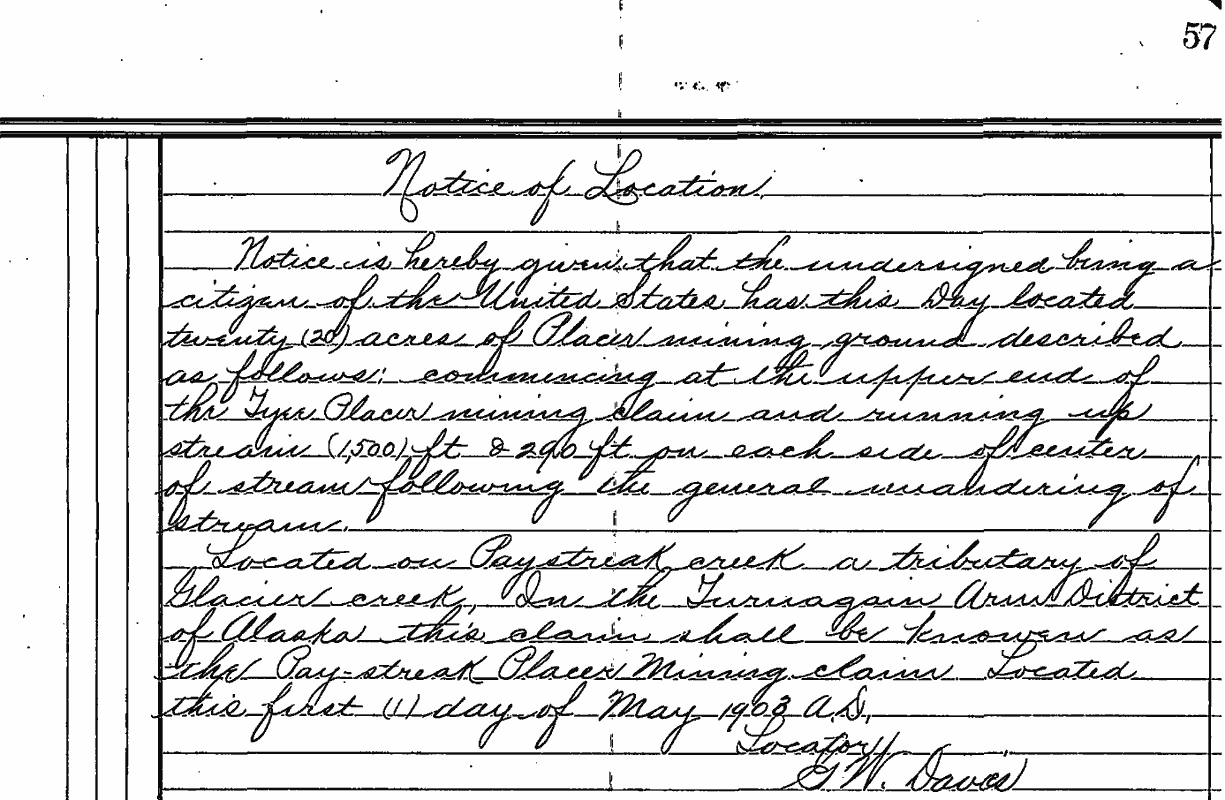Paystreak Creek
Auspicious, but not Auriferous.
Published 6-18-2021 | Last updated 6-18-2021
60.997, -149.056
[Unofficial name, no GNIS Entry]
These days the Glacier Creek valley upstream of Crow Creek Road and the Alyeska hotel is Girdwood’s quiet backyard. The valley is currently best known as the winter stomping grounds of backcountry skiers and Chugach Powder Guides. At the turn of the 20th Century, however, those cherished frozen creeks and the feet of powder blanketing spruce forests were obstacles men like George W. Davis would have loved to be rid of. Every unexplored creek bed potentially held gold, just frozen away from prying eyes and picks.
Interest in the region near Girdwood began when “placer gold was discovered on California Creek in 1895 and on Crow Creek in 1896, although there was no production until 1898.”[1] By 1903 Crow Creek was described as “booming” with one claim employing 40 men earning $12 each per day,[2] equivalent to $360 today.[3] But the standards for ‘booming’ were admittedly somewhat modest, with USGS geologist Moffitt noting at the close of that 1903 season that “the [cumulative] production of Glacier Creek Valley […] is over $51,000,”[4] equivalent to $1.5 million today,[3] over six years of development. Crow Creek was the major producer, California and Winner Creeks had contributed smaller fractions, and Virgin Creek had been prospected in 1898 but never yielded paying quantities. But much was still unexplored: “The source of the gold in veins was not discovered until about 1909”[1] and as late as 1933, C.F. Parks wrote “little is known about Winner Creek, and its headwaters have not been mapped.”[1] due to “the matted growths of alders and other brush”[1] New opportunities could be lurking anywhere.
On May 1st 1903, Davis seems to have taken a gamble on a previously overlooked creek. He staked the Paystreak Placer Claim, “located on Paystreak creek, a tributary of Glacier creek.”[5] The name Paystreak would have been an optimistic hunch as there was likely still snow still on the ground, and the common working season for Turnagain Arm and Kenai Peninsula prospectors was June to October[6][7]. That same day his companions F.C. Fleharty, Axel Lindblad, and R.E. Oldham each staked a neighboring claim on the creek. Fleharty staked the Tyee Placer Claim, meaning ‘Chief’ in the Chinook Jargon trading language of the Pacific Northwest. Lindblad, who cleared a trail up the lower section of Winner Creek[1] and ran a trapline on Glacier Creek for many years, staked the Trapper Placer Claim. Oldham, one of the first prospectors to explore the Girdwood area, staked the Vanger (or possibly the Vauger) Placer Claim.[4]
It's possible that Paystreak had been named prior to Davis, but not likely considering that the paystreak they did turn out to be a figment of hopeful imagination. USGS geologist Stephen R. Capps visited in 1916 and remarked “Paystreak Creek, the first tributary of Glacier Creek above Crow Creek, has also been prospected, but no paying ground was found.”[8]

Sources
[5] Hildreth, H.H. Notices of Location. Palmer Mining District Book 1, 57-60.
